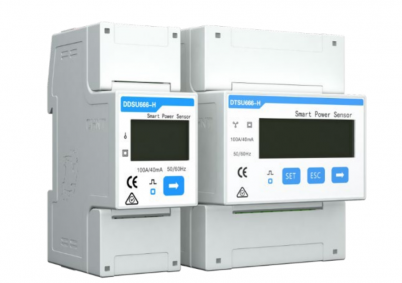Huawei’s solutions for hybrid systems
Introduction
Huawei is a very popular brand all over the world. It has proven itself in many areas: phones, laptops, smartwatches. For a few years now, the company has been trying to gain a share of the solar market, with relative success. Nowadays, Huawei has become almost inescapable in this industry. With the development of technology and the spread of PV, hybrid systems have become increasingly important. In this article, we look at Huawei’s solutions for hybrid systems.
Products
Single-phase products range from 2 to 6 kW. For this size class, they has 2 MPPTs as usual. They can be commissioned via the integrated WLAN module with the FusionSolar app. They have a really low start voltage of 100V, which means that a minimum of 3 of the current solar modules are required to start the MPPT.
Three-phase versions are available from 3 to 10 kW. Very similar in design to their single-phase cousins, they can also be installed using the FusionSolar app, but to connect to the internet you need to install the Smart Dongle-WLAN-FE device, which is included in the box, or possibly its 4G counterpart, which can be purchased separately. Its starting voltage is double, 200V, so the number of PV modules required for the miumim is also 6. The device is also equipped for PID, Potential Induced Degradation Reduction. It is well known that electrons are leaving the PV cells near the negative side of the strings. PID Recovery tries to eliminate this: it “recharges” these electrons with reverse polarity during the night, so it increases the system’s efficiency and lifetime.
The heart of hybrid systems is the battery: the Huawei Luna is available in a wide range. The smallest unit has a capacity of 5 kWh and consists of a single battery module, but you can connect up to three of these modules together to get 15 kWh. If that’s not enough, you can double the system, bringing the total capacity to 30 kWh. The charge control of these modules is done by a BMS, which is always essential for such a system.
In the event of a power failure, the Backup Box ensures that the network is galvanically isolated, yet the backup circuit can continue to operate without interruption. This device also communicates with the inverter, so it can send it a signal so that the inverter does not switch off when the grid is off, but continues to operate from batteries or PV. The backup function can deliver 5 kVA of power for one phase and 3.3 kVA for three phases. Unfortunately, the device is not capable of three-phase backup, and can only power backup circuits with one phase.
A smart meter is essential for the proper operation of the batteries: the single-phase is available as DDSU666-H and the three-phase as DTSU666-HW. In both cases, the package also includes the CTs needed for the measurement and a 10 m RS485 cable for communication between the inverter and the meter. The device measures how much the house is currently consuming, so it can control how much energy is charged to the batteries by comparing it with the inverter’s production data.
Functions
Huawei hybrid inverters have four modes of operation:
Maximum Self-Consumption
This setting allows as much of the locally generated energy as possible to be used locally, which is the main reason why hybrid systems are created. In this case, if we have surplus production, the system will charge the batteries as long as it can. When they are fully charged, the “excess” energy is exported to the grid, just as in conventional systems. When the PV does not produce enough energy to supply the house, the batteries help first, and then, when they are also discharged, we can buy power from the grid.
Time-of-Use Price
In some countries, energy is more expensive at certain times and cheaper at others. The system can be programmed to buy from the grid when it is cheaper to do so, and to export energy stored in batteries when it is expensive.
Fully Fed to Grid
This mode allows you to oversize the DC peak power, because if the solar energy produced during the day exceeds the maximum AC power of the inverter, the battery is charged with the remaining energy. If, on the other hand, the energy from the PV is less than the maximum output power of the inverter, the battery will start to discharge to maximize its output to the grid.
Pure Off-Grid
In Pure Off-Grid mode, the operation is similar to the “Maximum Self-Consumption” setting, except that the Backup Box disconnects the system from the grid, so it operates without it. Inverters support this mode only at 220/230/240 V on one phase.
Commissioning and monitoring
Once the system is installed, you can use the Funsion Solar app to commission the system. Using your phone’s camera, you first need to scan the barcode on the side of the inverter so that your phone can connect to the inverter’s network. The first time you log in, you will need to enter a password to log in later. In the settings we connect it to the local network to bring the system online. Once everything is set up correctly, we can see a schematic diagram of all the components in our system, where we can check that we have done everything correctly. If the communication of each device is wired correctly, the inverter will automatically detect it, no need to add them separately.
In the monitoring portal, you can choose views of how you want to see the power plants you operate: a list view showing the current performance of our systems, and the total energy produced today. In KIP view, you can see the summary indicators of all our plants: status of all inverters, alarms, total production, environmental indicators, financial indicators.
After adding the location and the user, you will have full access to the inverter remotely, as well as to all the devices connected to it. We can update the software of all devices remotely, as well as export the log file, which is the basis for all warranty process. From this, the manufacturer can extract all AC and DC side values, so in most cases no on-site troubleshooting is required to claim the warranty. We can even modify any settings or make detailed reports on both the inverter and the batteries.
Posts you might like:

Subscribe to our newsletter
so that you don’t miss any news!



















